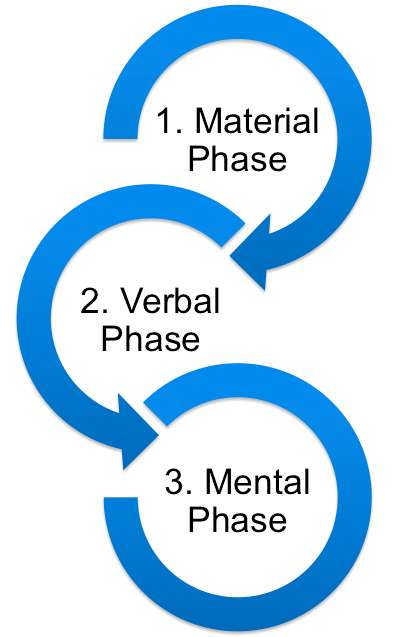Deep learning explained
It is very important for teachers to understand how concepts are internalized, how skills can be automatized and how they as mediators can professionally support that process.
SUCCESSFUL INTERNALIZATION OF CONCEPTS FOLLOWS THREE STEPS (VYGOTSKI):
UNDERSTANDING ABSTRACTION TRANSFER
1. Material Phase (promotes understanding of a concept):
To capture the systematic essence of a concept in ways that are not only understandable for the learners but which also allow them to apply that concept in subject specific tasks and activities, concepts need to introduced in a hands-on fashion with materials (material objects or charts, diagrams, models) which can be used and manipulated by the students.
Using materials (compare “DOING SCIENCE”) instead of relying on purely verbal instruction familiarizes students with the ways of getting things done in a specific subject and greatly reduces the risk of students memorizing content without any real understanding.
2. Verbal Phase (promotes abstraction of a concept):
As soon as students demonstrate that they can use a concept successfully with material support, it is necessary to remove those materials.
In a next step, students need to communicate the concept either to another (social communication) or to themselves (private speech). This step is absolutely essential because students gain control over a concept and its use through language, so they need to be provided with opportunities to share and deepen their conceptual understanding appropriately. Relying on verbal support in order to appropriately use a concept in a practical activity/task is an important step in transferring the knowledge of a concept and how to use it from the material to the mental plane because it helps students move towards an abstraction of the concept which is a fundamental step to use a concept in a wide array of different contexts.
3. Mental Phase (promotes transfer of conceptual knowledge):
As learners gain mastery over the concept through communication, the process becomes a purely mental one, it becomes inner speech. At this point, understanding and using a concept becomes completely mental. The individual is now able to use the concept successfully in different contexts and in creative ways.

SUMMING UP:
Language or better languaging is the key to successful internalization of concepts. Successful transfer of conceptual knowledge is only possible when concepts have successfully been moved from the material to the mental phase. Material support is very important in the beginning because it encourages students to really understand a concept rather than only memorizing and parroting it.
In other words, we have to dig deep before we can begin to develop transferable knowledge and skills.
FURTHER READING:
- - Lantolf, James P, and Matthew E. Poehner. Sociocultural Theory and the Pedagogical Imperative in L2 Education: Vygotskian Praxis and the Research/practice Divide. , 2014.
THE AUTOMATIZATION OF SKILLS ALSO FOLLOWS THREE STEPS AND REQUIRES CAREFULLY BALANCED PRACTICE ACTIVITIES AND TASKS AS WELL AS THE RIGHT KIND OF FEEDBACK
According to cognitive psychology, skills (see glossary: = “abilility to routinely, reliably and fluently perform goal-directed activities as a result of practice”) can be automatized through practice. Automatization is a powerful process because once we have automatized a skill, it requires fewer resources and allows usto pay attention to other things.
1. Cognitive Phase:
Learners receive explicit instruction about how to solve a task or they watch and observe an expert and try to imitate him/her. This stage requires deliberate attention and effort from the learner, performance is slow and full of mistakes.
2. Declarative Phase:
Through practice, declarative knowledge can become proceduralized.
3. Autonomous Phase:
In this stage, performance is automated, there are hardly any mistakes and learners usually are no longer aware of the individual ‘parts’ of an action.
It is very important to mention that declarative knowledge (i.e. rules about how to do sth./how to complete a task) is stored in a different part of the brain than procedural knowledge and unfortunately, there is no direct route from one memory system to the other. That is why students are usually able to parrot grammar rules but cannot apply that rule in a natural situation. To make things even more complicated, each memory system requires different types of practice activities
However, research has also shown that there are ways of promoting automaticity (the transfer from rule based to memory based system) in the classroom through a mix of
a) awareness raising activities
b) controlled practice
c) communicative practice
d) activities to reflect learning outcomes
e) scaffolding and feedback

Figure 3: Skill Acquisition, Practice and the Dual-Coded Memory Model – a synopsis (Meyer 2014)
FURTHER READING:
- DeKkeyser, R. (2007): Practice in a Second Language. Perspectives from Applied Linguistics and Cognitive Psychology. New York: Cambridge University Press.
- DeKeyser, R. (2001): Automaticity and automatization. In: Robinson, P. (ed). Cognition and Second Language Instruction (Cambridge Applied Linguistics). Cambridge: CUP, 125-151.
- Hassan, X. & Macaro, E. et al. (2005): Strategy Training in language learning: A systematic review of available research. In Research Evidence in Education Library. London: EPPI-Centre, Social Science Research Unit, University of London. //eppi.ioe.ac.uk/cms/LinkClick.aspx?fileticket=F%2FOwckdUekA%3D&tabid=296&mid=1147&language=en-US.
- Lyster, R. (2007): Learning and Teaching Languages Through Content: A counterbalanced approach. Amsterdam and Philadelphia: John Benjamins Publishing Company.
- Macaro, E. (2006): Strategies for Language Learning and for Language Use: Revising the Theoretical Framework. In: The Modern Language Journal, 90, iii, 320-337.
- Meyer, O. (2013). Zum Zusammenhang von fertigkeitsorientierten Lernstrategien und sprachlicher Performanz am Beispiel der Bildbeschreibung im erweiterten Englischunterricht (Unpublished doctoral thesis). Katholische Universität Eichstätt-Ingolstadt, Eichstätt.
-